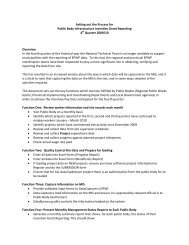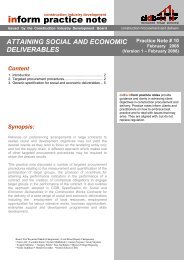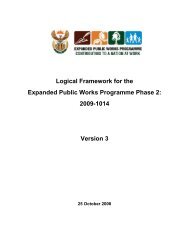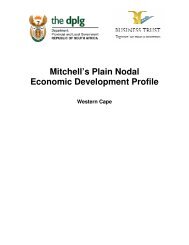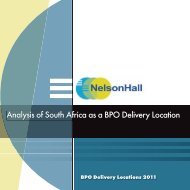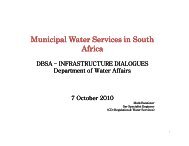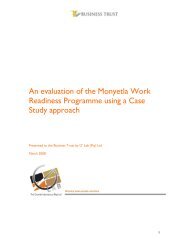National Infrastructure Maintenance Strategy - Construction Industry ...
National Infrastructure Maintenance Strategy - Construction Industry ...
National Infrastructure Maintenance Strategy - Construction Industry ...
You also want an ePaper? Increase the reach of your titles
YUMPU automatically turns print PDFs into web optimized ePapers that Google loves.
3.2.3 Category B<br />
Features<br />
Insufficient attention is being paid by the Category<br />
B institutions to the maintenance of the services<br />
infrastructure for which they are responsible. In<br />
addition, many have, due in part to neglect as well<br />
as changes in resource allocation and the pressure<br />
of increased demand, built up a substantial<br />
maintenance backlog. Competing demands on<br />
limited budgets (and on staff and other resources)<br />
severely constrain the proper maintenance of<br />
infrastructure, leading to service interruptions and<br />
other shortcomings.<br />
The "large proportion of their trained staff will be<br />
retiring" problem, described in Section 3.2.2, is a<br />
common problem in Category B. That is, they will<br />
be leaving, or they have already left during the last<br />
few years (many retired early).<br />
Three major issues significant to water boards and<br />
especially municipalities are:<br />
• These two sectors have been subject to radical<br />
change since 1994. There have been two<br />
rounds of demarcation of municipal<br />
boundaries, in 1996 and again in 2000. Each of<br />
the rounds has seen major changes in political<br />
leadership, staff and systems -- many staff have<br />
left, or been assigned new duties or new areas,<br />
many new staff have joined, and staff profiles<br />
have changed. Responsibility for the<br />
administration of and provision of services to<br />
very large areas of deprivation has been<br />
assigned to unified administrations. Among<br />
these administrations that have struggled the<br />
most to provide services have been those<br />
responsible for geographical areas that had few<br />
resources even prior to 1996, and in which<br />
there was little existing local foundation upon<br />
which to build the new administration. New<br />
responsibilities have been assigned to<br />
municipalities and water boards. <strong>National</strong><br />
government funding has enabled the<br />
acquisition of new infrastructure on a very large<br />
scale. Old funding sources have fallen away,<br />
and new ones have come in. It is not surprising<br />
therefore that for these reasons alone many<br />
municipalities and water boards have struggled<br />
to give the necessary attention to maintenance<br />
issues.<br />
No comprehensive national<br />
data on the condition and age of<br />
[electrical distribution]<br />
infrastructure exists.<br />
(NER 2004:2)<br />
• Due to the dispersed and decentralised nature<br />
of municipalities and water boards, there is no<br />
comprehensive dataset on the condition of their<br />
infrastructure assets, but the indications are<br />
that this infrastructure is generally not in a good<br />
state outside the metropolitan and other large<br />
urban areas, although there are some<br />
exceptions. This is largely due to the<br />
widespread inadequacy of institutional<br />
capacity, both technical and financial, to<br />
operate and maintain the infrastructure - for<br />
example, many municipalities have no technical<br />
staff above operator level. Many of the<br />
municipalities suffer chronic financial problems<br />
and this considerably exacerbates this plight.<br />
The effects, such as worsening effluent quality<br />
from many wastewater treatment works, are<br />
cause for great concern. Information on trends<br />
in the condition of infrastructure is almost<br />
completely lacking outside of a select few of the<br />
municipalities and water boards.<br />
• Furthermore, it is clear that an unintended<br />
c o n s e q u e n c e o f c o n s t r u c t i n g m o r e<br />
infrastructure is in many municipalities<br />
resulting in a widening of the gap in<br />
infrastructure maintenance, as even new<br />
infrastructure requires maintenance. Without<br />
concerted assistance, many already stressed<br />
municipalities will be unable to maintain<br />
increasing amounts of infrastructure.<br />
Summarising features of some of the sectors other<br />
than water boards and municipalities:<br />
• The condition of the majority of provincial<br />
assets (and recalling that a minority of the<br />
provincial roads, health and education<br />
institutions lie in Category A) varies from fair to<br />
poor. A significant proportion of the health and<br />
education facilities, and especially their<br />
mechanical and electrical equipment, is in a<br />
poor state.<br />
• Particularly lacking are overviews of trends in<br />
the state of performance, and maintenance, of<br />
national infrastructure maintenance strategy<br />
10



